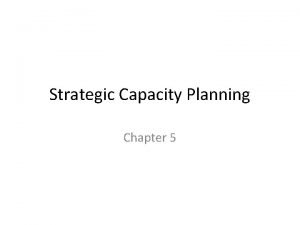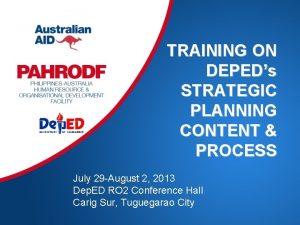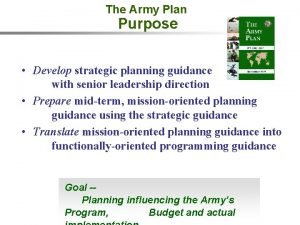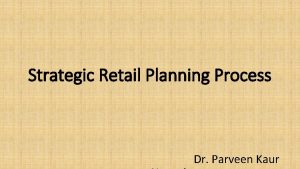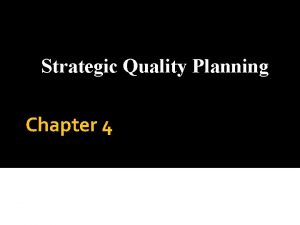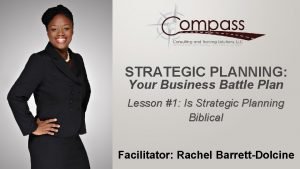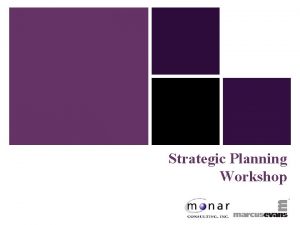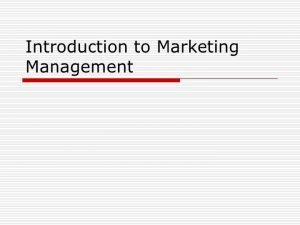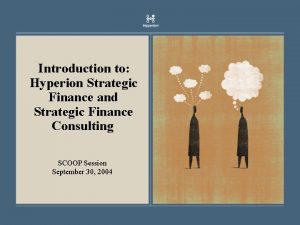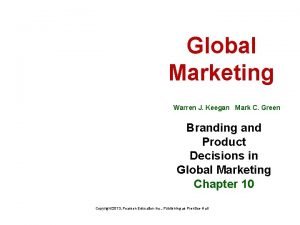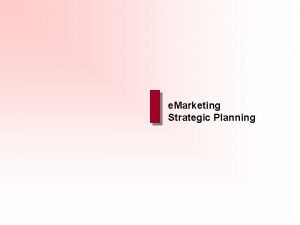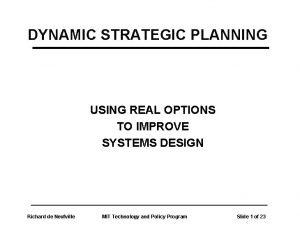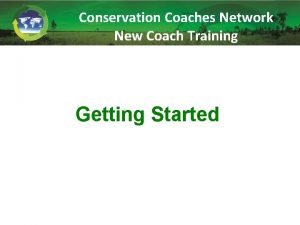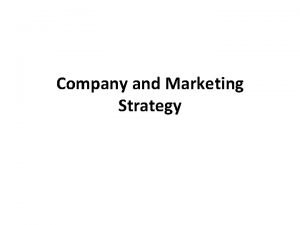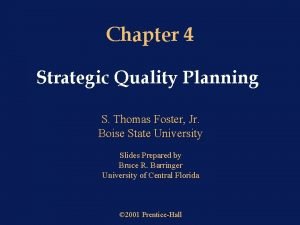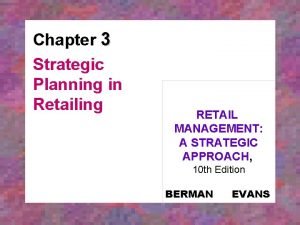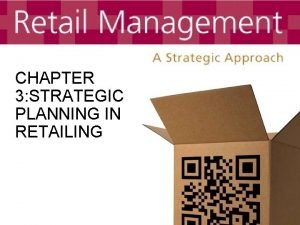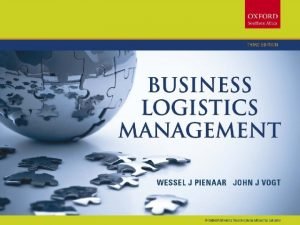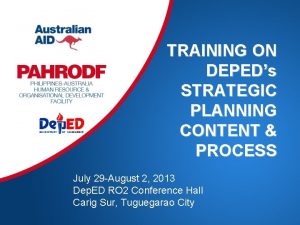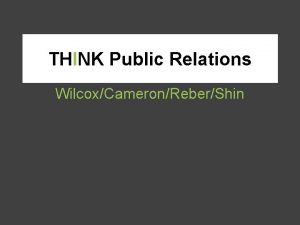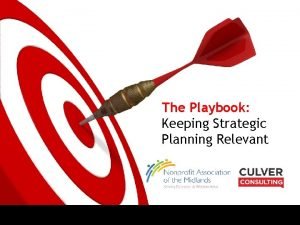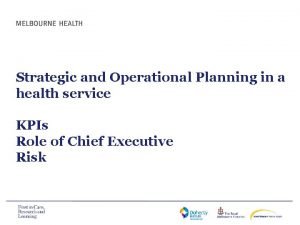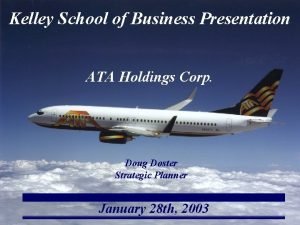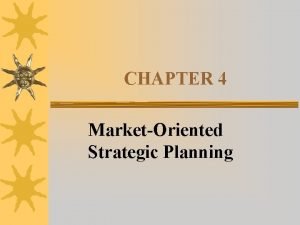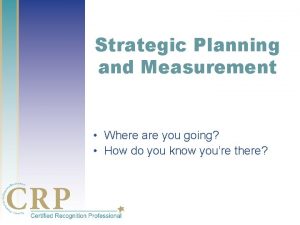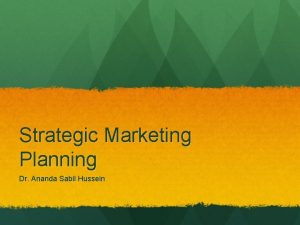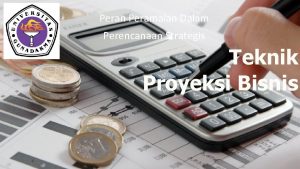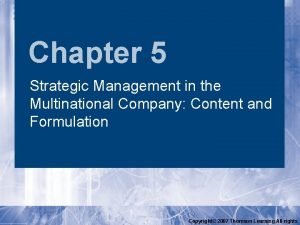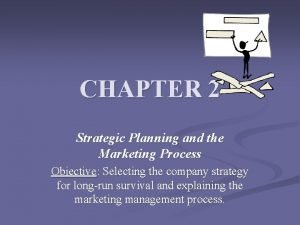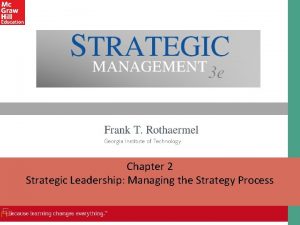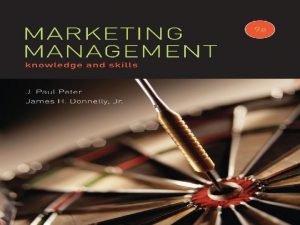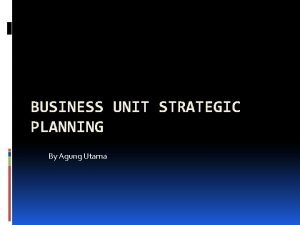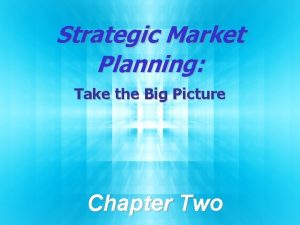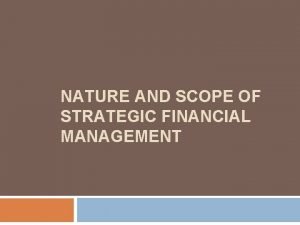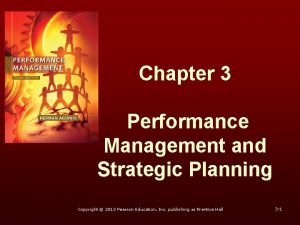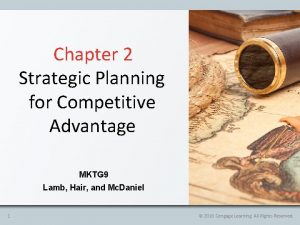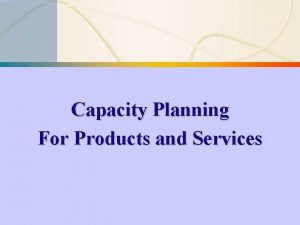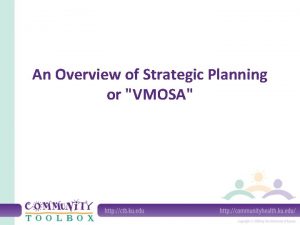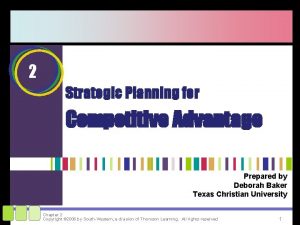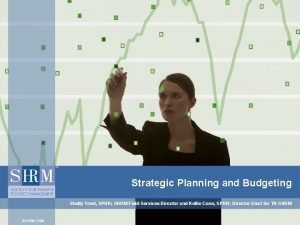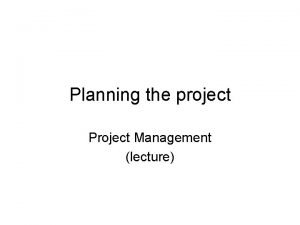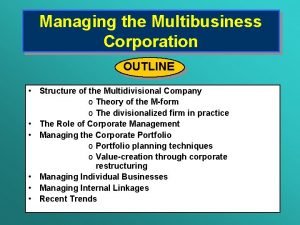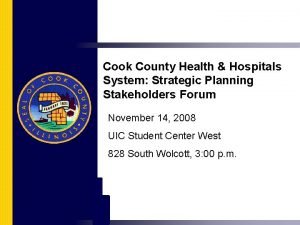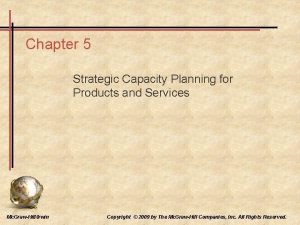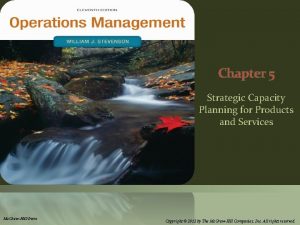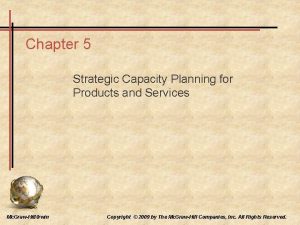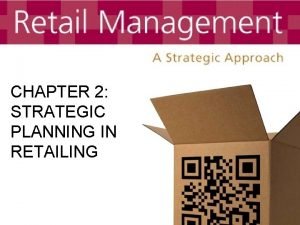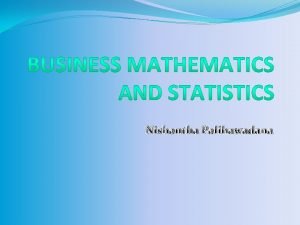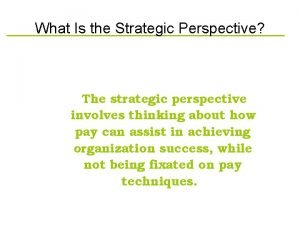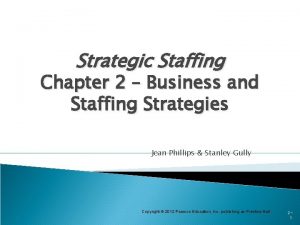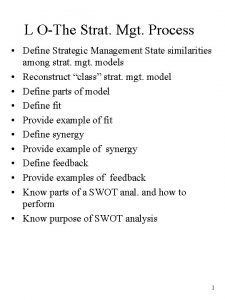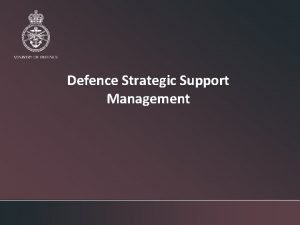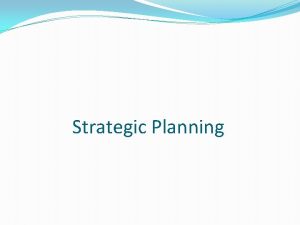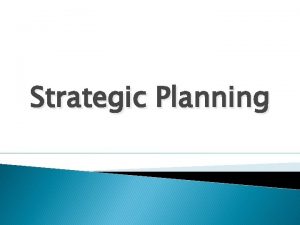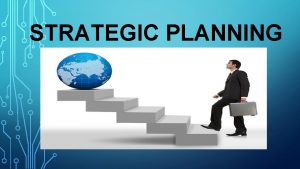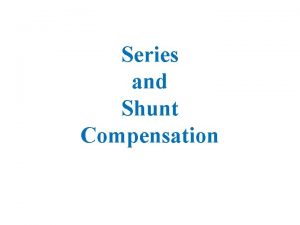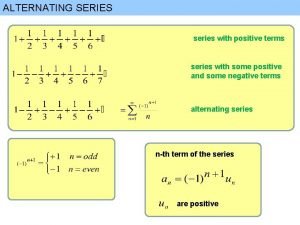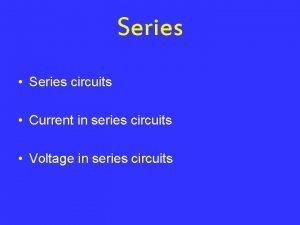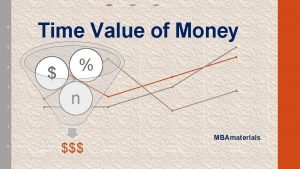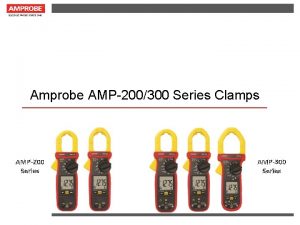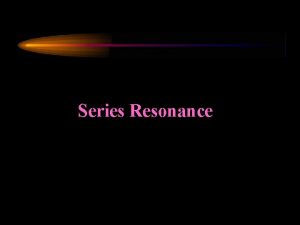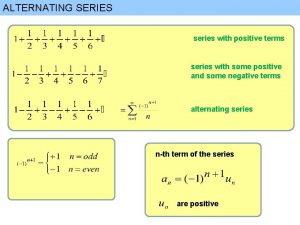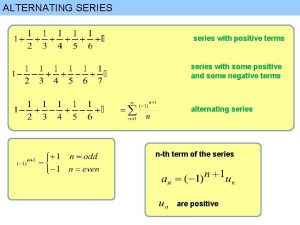Strategic Planning Definition Strategic Planning A series of

































































































- Slides: 97

Strategic Planning

Definition: Strategic Planning= A series of goaldirected decisions & actions MATCHING your skills & resources (strengths & weaknesses) w/ market threats & opportunities

Strategic Planning EVOLVING MARKET OPPORTUNITIES and/or threats RESOURCES& OBJECTIVES LONG RUN PROFITABILITY AND GROWTH

Where are we- in course?

M A N A G E M E N T Situation/SW OT Analysis S I M U LA T I ON The Big Picture Strategic Planning • Company • Consumers • Competitors • Conditions • PEST Growth & Competiti ve Strategi es Function al Integratio n Function al Integrati Marketin on g R&D Producti on HR Finance Performan ce Assessme nt Ø Profits Ø Mrkt Share Ø ROA Ø ROS Ø ROE Ø Asset T/O Ø Stock Ø Mrkt Cap

Begun-Step # 1 Situation & SWOT Analysis Company Consumer Competitors Conditions

Situation & SWOT Analysis answers 1 st of 3 Critical Questions: Where are we nowas a

You are finding answers re: Consumers Competitors Conditions v. How the market is segmented & the relevant criteria that influence consumers use in their purchasing decisions v. The nature & magnitude of the competition v. Existing & emerging Economic & Technological trends that will impact demand, pricing, product design & positioning

ANDYour Company:

Strategic Planning answers next 2 critical Q’s 2. Where do we want to go? 3. How do we get there?

Corp. Mission & Vision 2. Where do we want to go? – – What business(es) should be in Market positions to stake out? Consumer needs & segments serve? Outcomes to achieve?

Mission or Purpose is a precise description of what an organization does. It should describe the business the organization is in. It is a definition of “why” the organization exists A vision is a statement about what your organization wants to become … A compelling description of the state and function of the organization once it has implemented and achieved the strategic plan…

Final Question answered by Strategic Planning: 1. Where are we now? 2. Where do we want to go? 3. How do we get there? *Growth, Competitive & Functional Strategies

“If you don’t know where you are going any route will get you there. ” Chris Bartlett, Harvard Business School

rd 3 Q- Encompasses 3 Levels of Strategy Corporate-Level : In what business should we compete? Corporation Business-Level : How should we compete? Sensors Unit Nano-Tech Unit Cons. Elec. Unit Functional-Level : How do we coordinate? Finance HR / R&D Production Marketing

Corporate Growth Strategy Business Unit Competitive Strategy Functional Strategies R&D Marketing Finance Production Human Resources

Level 1 -Corporate Strategy In which businesses do we comp Corporation ?

Once decided what businesses to compete in –need to decide - what Products & Markets to compete w/& in= Growth Strategy

The Big Picture Situation/SW OT Analysis Strategic Planning • Company • Consumers • Competitors • Conditions • PEST Function Performan al ce Integratio Assessme n Functional nt Integration Growth & Competiti ve Strategi es Marketing R&D Production HR Finance Ø Profits Ø Mrkt Share Ø ROA Ø ROS Ø ROE Ø Asset T/O Ø Stock Ø Mrkt Cap

Growth Strategies PRODUCT Present Market Penetration New Product Development MARKET New Market Development Diversification

To Concentrate or Diversify… that is the question…

Concentrate on your primary line of business look for ways to meet growth objectives thru increasing your level of operation in your primary business Market Penetration Increase market share among existing customers. Market Development Attract new customers to existing products Product Development Create new products for present markets

2 nd Level of Strategy Corporate Level Business unit Level Functional strategy Information systems Research & development Finance Manufacturing Marketing Human resources

Level 2: Business Unit Strategy: How do we Compete? Focus? Quality? Price? STRATEGIC BUSINESS UNIT MARKET COMPETITOR A COMPETITOR B COMPETITOR C

What Advantage can we create & sustain against our competitors? & w/in which Market Segments should we compete?

l Competitive Strategy is the creation of a unique & valuable position- The position is based on– Performing the same activities as competitors, but differently --or performing a different set of activities • Porters Generic Strategies • Strategies & Mission Statements

The Big Picture Situation/SW OT Analysis Strategic Planning • Company • Consumers • Competitors • Conditions • PEST Function Performan al ce Integratio Assessme n Functional nt Integration Growth & Competiti ve Strategi es Marketing R&D Production HR Finance Ø Profits Ø Mrkt Share Ø ROA Ø ROS Ø ROE Ø Asset T/O Ø Stock Ø Mrkt Cap

You can Formulate Strategy based on what Competitive advantage you focus on: Cost: Design, produce, market more efficiently than competitors Differentiation: Differentiation Deliver unique & superior value in terms of product quality, features, service

You can Formulate Strategy thru your Competitive Scope: Number & Nature of segments compete w/in-

Generic Strategies Competitive Advantage Broad target Narrow target Competitive Scope Cost Uniqueness Cost Broad Leadershi Differentiation p Focused Cost Leadershi p Focused Differentiati on

& You can also Formulate Strategy by-Riding a Products Life Cycle n Adjust Marketing Mix according to natural Drift of products w/in segments-

Put them all together &… 1. Cost/Quality Differentiation 2. Number & nature of segments compete w/in 3. Riding the Product Life Cycle

Number & nature of segments compete w/in #2 Compete Broad Market on: Cost #1 Product Quality Niche Mrkt Ride Product Life. Cycle #3 Evolving Mrkt Competitive Strategy Matrix

Competitive Strategy Matrix Broad Mrkt Compete on: Cost Product Quality Niche Mrkt Overall Cost Leader. Lo -Tech Leader Focus Differentiator- Differentiator Hi- End Focus Evolving Mrkt Cost Leader PLC Lo+Trad+Hi Differentiator. PLC Lo+Trad+Hi

This week’s assignments Select w/ which of the Six Basic Strategies you are going to compete n Draft- your Mission & Vision statements Determine Functional Tactics & Objectives n Marketing n n n Production n n R&D HR, TQM Financial

Cost Leadership Strategic Choices A cost leader does not try to be industry innovator l The overriding goal is- increased efficiency & lower costs relative to rivals l Will seek to minimize costs in marketing, R&D & production l

Cost Leadership Actions necessary to gain & maintain position: 1. Economies of scale thru utilization of excess capacity. 2. Automation / utilization of robotics in manufacturing processes. 3. Development of efficient distribution networks. 4. Implementation of TQM (Total Quality Management) initiatives. Example: Dell

Business-Level Strategy: Cost Leadership l Advantages –A cost leader is able to charge lower prices – Even at same price more efficient cost leader generates greater profitability

Overall Cost Leader. Lo -Tech Leader Focus n Cost Leader PLC Lo+Trad+Hi An overall cost leader will attempt to be low-cost producer in every segment of the market.

Overall Cost Leader. Lo -Tech Leader Focus Cost Leader PLC Lo+Trad+Hi -- seeks to dominate the price sensitive market segments. n --sets prices below all competitors — and still be profitable n

Overall Cost Leader. Lo -Tech Leader Focus n Products will be allowed to age & change in appeal from High End, to Traditional, and eventually Cost Leader PLC Lo+Trad+Hi

Competitive Strategy Matrix Broad Mrkt Compete on: Cost Product Quality Niche Mrkt Overall Cost Leader. Lo -Tech Leader Focus Differentiator- Differentiator Hi- End Focus Evolving Mrkt Cost Leader PLC Lo+Trad+Hi Differentiator. PLC Lo+Trad+Hi

Generic Business-Level Strategy: Differentiation Create a product that customers perceive as distinct/unique & offer superior quality/service Advantage Customers expect & willing to pay premium prices

Differentiator l l Will have significant expenditures in R&D & production…. Because you want/need to make high quality/highly desirable product Will have significant expenditures in marketing… Because you need to create maximum awareness & brand equity.

Differentiation Actions necessary to gain / maintain position: 1. Developing innovative products/services to broad range of customers. 2. Significant investments in R&D. 3. Capability to generate a series of successful new products over time. 4. Development of flexible manufacturing systems. Example: Toyota

Differentiation Advantage … as you develop greater brand equity —thru increased product quality & awareness …. You develop greater brand loyalty…. The greater the loyalty. . the less the price sensitivity

Differentiation: Disadvantages Difficulty in maintaining long-term distinction in customers’ eyes – Agile competitors can quickly imitate l Difficulty/expense of maintaining premium pricing– requires greater marketing costs l

Broad Niche Differentiati on - PLC Differentiatio n Hi -Tech Lo+Trad+Hi n Focus match their ideal criteria for positioning, age, and reliability.

3 rd Level of Strategy Corporate Level Business unit Level Functional Strategy Information systems Research & development Finance Manufacturing Marketing Human resources

Level 3 Functional Strategy How do we coordinate?

The Big Picture Situation/SW OT Analysis Strategic Planning • Company • Consumers • Competitors • Conditions • PEST Growth & Competiti ve Strategi es Function al Integratio n Marketing R&D Production HR Finance Performan ce Assessme nt Ø Profits Ø Mrkt Share Ø ROA Ø ROS Ø ROE Ø Asset T/O Ø Stock Ø Mrkt Cap

INTERNAL STRATEGIC ALIGNMENT Achieved when : All Decisions made by & within all functional areas are in sync w/ one another, As well as with the overall strategic direction of the firm FINANCE PRODUCTION MARKETING

For INTERNAL STRATEGIC ALIGNMENT to occur: l Marketing/R&D must be operating in a manner that is complementary to Production l Which is complementary to Human Resources l Which is complementary to Finance.

… after divining strategy still have task of implementation & performance Marketing Strategy Organizational Structure Training & Reward Programs Human Resources Communicate Implementation Motivate Coordinate Marketing Performance Climate and Culture

The Recurring Problem… l Only 5% of workforce “on board” w/ the strategy l Only 25% of managers have incentives linked to strategy l 60% of organizations don't link budgets & strategy l 85% of executive teams spend <1 hour/ month discussing strategy l 90% fail to execute strategy successfully Robert S. Kaplan and David P. Norton The Strategy-Focused Organization, 2000

Problem: Separation of Strategic Planning & Marketing Implementation Very Much Time Spent Strategic Planning • Commitment • Understandin g Strategy • Responsibilit Implementation y Very Little Chief Executive Officer Mid-level Managers Customer Contact

Benefits of “Strategic Planning” ü Guides entire firm regarding -what it is you are trying to do & achieve ü Unifies numerous strategy-related decisions and organizational efforts objectives Strategy Operations

Forces you to make choices on what you will & won’t do

What makes a decision strategic? ü Multi- functional in scope & consequences ü Requires choice & trade-offs, integration & alignment

In order to execute & achieve selected growth & competitive strategies--Need to coordinate decisions across all Functional domains Production R&D Marketing Finance HR

Examples of Strategic Alignment

Functional Alignment: In Achieving Cost Efficiency

Functional Alignment: Implementing Differentiation Strategy

Functional Alignment: In Achieving Superior Innovation

Functional Alignment: Superior Customer Rlshps


When all decisions made by & within all functional areas are in sync w/ one another, As well as w/ your overall strategic direction -- you achieve… Distinctive Competencies

Distinct competencies needed to achieve selected competitive strategy Distinctive Competencies Competitive Advantage* *Achieved when you sustain profits above Industry Average

Areas in which you can develop “Distinct Competencies” n n MARKETING: Awareness & Accessibility R&D: Product innovation & design PRODUCTION: Plant Automation & utilization Human Resources: Worker Expertise & Training

Distinct Competencies in automation & human resources could lead to a competitive advantage in cost leadership.

Achieving Competitive Advantage thru Cost-Focused Strategy n Allows for good profit margins on sales while keeping prices low especially in price-sensitive segments… Functional Alignment Production Marketing R&D üAutomation - pursued early & aggressively üCapacity improvements unlikely (may run overtime instead) Spend moderately on promotion & sales Spend minimally on R&D

Distinct Competencies in awareness, accessibility & design could lead to a competitive advantage built upon differentiation

Differentiator n n Seeks to create maximum awareness & brand equity. Wants to be well known as a maker of high quality/highly desirable products Functional Alignment Production Less likely to invest in increased automation or production capacity Marketing Spend heavy on advertising & sales to create maximum awareness & accessibility Prices tend to be higher High R&D spending - keep products fresh R&D

Virtually all tactical mistakes that are made when implementing strategy are a consequence of the lack of synchronization of decisions made in at least two functional areas

n You develop a new product but forget to buy plant & equipment for it…the year before it is to be launched… R&D and Production breakdown

n The company takes an emergency loan because inventory levels increase… Marketing, Production & Finance out of sync

n You reposition a product from the High End to the Traditional segment, but do not address their material & labor costs… Marketing, R&D, and Production out of sync

n Financial decisions are made before knowing the budget demands of all R&D, Marketing and Production decisions… Everybody is out of sync!

This week’s assignments Select w/ which of the Six Basic Strategies you are going to compete n Draft- your Mission & Vision statements Determine Functional Tactics & Objectives n Marketing n n n Production n n R&D HR, TQM Financial

Writing Mission & Vision Statements

Avoid Mission Myopia Short sightedness by firms that define their business too narrowly

Marketing Myopia Examples Myopic Description: l Railroad company l Electricity company l Television network Broad Description: l Transportation Co. l Power company l Entertainment provider

Market Oriented Vision / Missions COMPANY PRODUCTORIENTED VISION/MISSION STATEMENTS MARKET-ORIENTED VISION/MISSION STATEMENTS Revlon We make cosmetics. We sell hope…we accent a lifestyle & self expression Disney We run theme parks. We make people happy. . by providing fantastic experiences & entertainment Philip Morris We Sell Cigarettes Altria We provide “Life's Simple Pleasures”


Types of objectives n n n n Profitability Growth Market share Social responsibility Employee welfare Product Quality Service n n n R&D Diversification Efficiency Financial stability Resource conservation Mgt & labor development


Mission Statement We will produce outstanding financial returns by providing totally reliable, competitively superior, global, air-ground transportation of high-priority goods and documents that require rapid, time-certain delivery. "

“Pepsi. Co’s overall mission is to increase the value of our shareholders’ investment. We do this through sales growth, cost controls and wise investment of resources. We believe our commercial success depends upon offering quality and value to our consumers and customers; providing products that are safe, wholesome, economically efficient and environmentally sound; and providing a fair return to our investors while

Valuable Capstone: Strategies & Mission Statements http: //www. bplans. com/dp/missionstatement. cfm >Strategy & Vision Statements

Getting it together

Need to begin to determine the basic objectives & specific tactical decisions that need to be made within & across each management domain …in order to successfully implement your growth & competitive strategies

This week’s assignments n n Select w/ which of the Six Basic Strategies you are going to compete Draft- your Mission & Vision statements Determine Functional Objectives & Tactics n Marketing n n R&D Production n n HR, TQM Financial

Competiti ve Strategy: ND Strategic Objectives Marketin Spend aggressively in promotion & sales in Hitech segments…. make our products easy for customers to find. . . price at a g premium. In the low tech segments we”ll exit gracefully, … as they exit the Low End R&D We will keep our existing Hi. Tech products (HI, PRF, & SIZE), phase out TRAD and LO, and introduce a new brand in the High End segment. Our goal is to offer technology oriented customers products that match their ideal criteria for positioning, age, and reliability Producti Grow capacity to meet demand … avoid overtime After products well positioned, investigate modest increases in automation on levels to improve margins, but keep ability to reposition products HR Finance Spend aggressively on recruitment, training; minimize labor T/O w/ +wage & benefit packages; Focus TQM & Process initiatives on reducing labor & material costs, R&D time and enhancing effectiveness of promo & sales budgets… We”ll finance investments primarily thru stock issues, retained earnings, supplement w/ bond offerings as needed. . When our

Competiti ve Strategy: ND Tactics Year 1 TRAD – increase price, make modest cuts in promotion and sales budget. Forecast a modest reduction in unit sales compared to last year. Example: price $28. 50, promotion budget $600, sales budget $600, and sales forecast 1000. LO – increase price, make modest cuts in promotion and sales budget. Forecast a modest reduction in unit sales compared to last year. Example: $23. 50, Marketin promotion budget $600, sales $800, and sales forecast g 1400. HI – increase price, promotion budget and sales budget. Forecast flat unit sales. Example: $39. 50, promotion budget $1900, sales forecast 400. PRF – increase price, promotion budget and sales budget. Forecast flat unit sales. Example: $34. 50, promotion budget $1900, sales forecast 440. SIZ –increase price, promotion budget and sales budget.

Competitiv e Strategy: N D R&D Tactics Year 1 TRAD – tweak positioning to reduce age. Reduce reliability to reduce material cost. Example: Increase Performance by 0. 1 and reduce MTBF by 1000 hours. LO – leave positioning alone, allowing the product to age further. Reduce reliability to reduce material cost. Example: reduce MTBF by 1000 hours. . HI– improve positioning and reduce age. Hold reliability (MTBF) steady. Example: reduce Size by 1. 2, and increase Performance by 1. 2. PRF – improve positioning and reduce age. Improve reliability to enhance demand. Example: Increase Performance by 1. 4, reduce Size by 0. 5, and increase MTBF by 1000 hours. SIZE – improve positioning and reduce age. Hold reliability (MTBF) steady. Example: Reduce Size by 1. 4, and increase Performance by 0. 5. New HI – Launch a new High End product, with a project length of 20 to 23 months (no later than December of next

TACTICS -Example: decision matrix- to add a new High End product… PRODUCTI ON What= A New product- Size coordinate = 10. Performance coordinate = 11. MTBF = 25, 000 hours. When Due out in 2009 What= Competitively Price @ $35. Promo : target 68% Awareness (50% @intro +18% will cost=$2 M) vehicle-allocation= web, email & Trade Shows. maintain hi-level Distribution w/ Sales budget = $1. 4 M When 2009. What Produce 75, 000 units at automation level of 3. When Ready by second month of 2009. How Purchase capacity in 2008 HR What make appropo investments in recruiting & training and TQM FINANCE What Finance $11 M. When NOW. How Issue long term debt. R&D MARKETI NG

- No "magic bullet " guaranteed winning strategy. Each simulation has a unique competitive dynamic. Successful contingent on planning, strategic alignment, teamwork, competitor analysis, & tactical adjustments.
 Strategic planning vs tactical planning
Strategic planning vs tactical planning Maclaurin series vs taylor series
Maclaurin series vs taylor series Heisenberg 1925 paper
Heisenberg 1925 paper Taylor vs maclaurin
Taylor vs maclaurin Maclaurin polynomial
Maclaurin polynomial Ibm p series servers
Ibm p series servers General feedback structure
General feedback structure Series aiding and series opposing
Series aiding and series opposing Sum of infinite series formula
Sum of infinite series formula Types of corporate strategies
Types of corporate strategies Strategic capacity planning definition
Strategic capacity planning definition Strategic fit vs strategic intent
Strategic fit vs strategic intent Strategic substitutes and strategic complements
Strategic substitutes and strategic complements Strategic management and strategic competitiveness
Strategic management and strategic competitiveness Strategy analysis and choice largely involves making
Strategy analysis and choice largely involves making Right to left strategic planning framework
Right to left strategic planning framework The army plan (tap) 2020
The army plan (tap) 2020 Retail strategic planning
Retail strategic planning Strategic quality plan
Strategic quality plan Is strategic planning biblical
Is strategic planning biblical Strategic planning workshop exercises
Strategic planning workshop exercises Marketing plan process
Marketing plan process Retail management strategies
Retail management strategies Activity 1 know thyself better let's get swot-ing
Activity 1 know thyself better let's get swot-ing Hyperion strategic finance vs hyperion planning
Hyperion strategic finance vs hyperion planning Global product planning: strategic alternatives
Global product planning: strategic alternatives E marketing strategic planning
E marketing strategic planning Dynamic strategic planning
Dynamic strategic planning Strategic conservation planning
Strategic conservation planning Company wide strategic planning and its four steps
Company wide strategic planning and its four steps Lundvall juran model
Lundvall juran model Strategic planning in retailing chapter 3
Strategic planning in retailing chapter 3 Strategic planning in retailing
Strategic planning in retailing Vision statement for supply chain management
Vision statement for supply chain management Brand and product decisions in global marketing
Brand and product decisions in global marketing Joint strategic planning system
Joint strategic planning system Deped strategic planning sample
Deped strategic planning sample The most precise random sampling is usually done from
The most precise random sampling is usually done from Strategic planning playbook
Strategic planning playbook Strategic planning for competitive advantage
Strategic planning for competitive advantage Strategic and operational planning in healthcare
Strategic and operational planning in healthcare Strategic planning career path
Strategic planning career path Hirarki perencanaan manajemen
Hirarki perencanaan manajemen Strategic and operational planning
Strategic and operational planning Market oriented strategic planning
Market oriented strategic planning Strategic workforce planning toolkit
Strategic workforce planning toolkit Visual strategic planning
Visual strategic planning Strategic planning in tqm
Strategic planning in tqm Swot analysis of english department
Swot analysis of english department Chapter 2 strategic planning for competitive advantage
Chapter 2 strategic planning for competitive advantage Buildin a strategic planning scorecard is based on mcq
Buildin a strategic planning scorecard is based on mcq Challenges of strategic marketing planning
Challenges of strategic marketing planning Traditional strategic planning
Traditional strategic planning Strategic forecasting
Strategic forecasting Strategic planning in multinational companies
Strategic planning in multinational companies The major activity in strategic planning is
The major activity in strategic planning is The afi strategy framework
The afi strategy framework Strategic planning in marketing
Strategic planning in marketing Business unit strategic planning
Business unit strategic planning Strategic planning process suffolk
Strategic planning process suffolk Bigpicture strategic planning
Bigpicture strategic planning Scope of strategic management accounting
Scope of strategic management accounting Strategic workforce planning swp
Strategic workforce planning swp Performance management and strategic planning
Performance management and strategic planning Strategic planning for competitive advantage
Strategic planning for competitive advantage Products and services
Products and services What is vmosa
What is vmosa Strategic planning for competitive advantage
Strategic planning for competitive advantage Strategic planning workshop greater manchester
Strategic planning workshop greater manchester Shrm strategic planning
Shrm strategic planning Strategic planning rotherham
Strategic planning rotherham Strategic planning real estate
Strategic planning real estate Gozinto chart
Gozinto chart Multibusiness corporation
Multibusiness corporation Strategic planning questions for stakeholders
Strategic planning questions for stakeholders Strategic capacity planning for products and services
Strategic capacity planning for products and services Strategic capacity planning for products and services
Strategic capacity planning for products and services Strategic capacity planning for products and services
Strategic capacity planning for products and services Company wide strategic planning
Company wide strategic planning Strategic planning in retailing
Strategic planning in retailing Aggregate capacity planning
Aggregate capacity planning What is the definition of homologous series
What is the definition of homologous series Utility of time series
Utility of time series Time series definition
Time series definition Bonding in organometallic compounds
Bonding in organometallic compounds Homologous series
Homologous series Planning balance sheet in urban planning
Planning balance sheet in urban planning Role segmentation workforce planning
Role segmentation workforce planning Proactive planning and reactive planning
Proactive planning and reactive planning Perencanaan agregat ppt
Perencanaan agregat ppt Long term plan and short term plan
Long term plan and short term plan Language planning slideshare
Language planning slideshare Examples of aggregate planning
Examples of aggregate planning What is a strategic perspective
What is a strategic perspective Types of staffing strategies
Types of staffing strategies Strategic staffing definition
Strategic staffing definition Definition of strategic management
Definition of strategic management Management support definition
Management support definition










